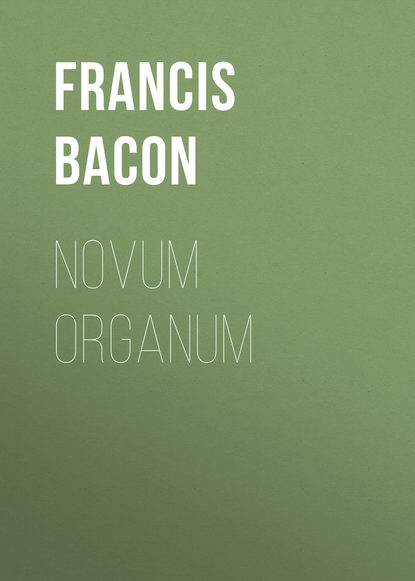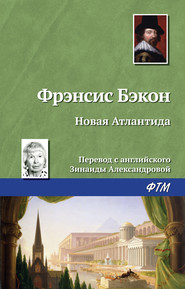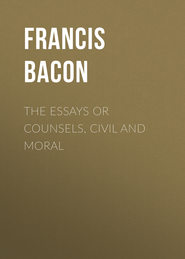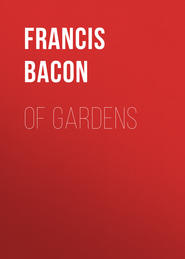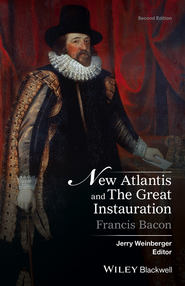По всем вопросам обращайтесь на: info@litportal.ru
(©) 2003-2024.
✖
Novum Organum
Настройки чтения
Размер шрифта
Высота строк
Поля
But if our forms appear to any one to be somewhat abstracted, from their mingling and uniting heterogeneous objects (the heat, for instance, of the heavenly bodies appears to be very different from that of fire; the fixed red of the rose and the like, from that which is apparent in the rainbow, or the radiation of opal or the diamond;[101 - This general law or form has been well illustrated by Newton’s discovery of the decomposition of colors.] death by drowning, from that by burning, the sword, apoplexy, or consumption; and yet they all agree in the common natures of heat, redness, and death), let him be assured that his understanding is inthralled by habit, by general appearances and hypotheses. For it is most certain that, however heterogeneous and distinct, they agree in the form or law which regulates heat, redness, or death; and that human power cannot be emancipated and freed from the common course of nature, and expanded and exalted to new efficients and new modes of operation, except by the revelation and invention of forms of this nature. But after this[102 - I.e., the common link or form which connects the various kinds of natures, such as the different hot or red natures enumerated above. – See Aphorism iii. part 2 (#Page_110).] union of nature, which is the principal point, we will afterward, in its proper place, treat of the divisions and ramifications of nature, whether ordinary or internal and more real.
XVIII. We must now offer an example of the exclusion or rejection of natures found by the tables of review, not to be of the form of heat; first premising that not only each table is sufficient for the rejection of any nature, but even each single instance contained in them. For it is clear from what has been said that every contradictory instance destroys a hypothesis as to the form. Still, however, for the sake of clearness, and in order to show more plainly the use of the tables, we redouble or repeat the exclusive.
An Example of the Exclusive Table, or of the Rejection of Natures from the Form of Heat
1. On account of the sun’s rays, reject elementary (or terrestrial) nature.
2. On account of common fire, and particularly subterranean fires (which are the most remote and secluded from the rays of the heavenly bodies), reject celestial nature.
3. On account of the heat acquired by every description of substances (as minerals, vegetables, the external parts of animals, water, oil, air, etc.) by mere approximation to the fire or any warm body, reject all variety and delicate texture of bodies.
4. On account of iron and ignited metals, which warm other bodies, and yet neither lose their weight nor substance, reject the imparting or mixing of the substance of the heating body.
5. On account of boiling water and air, and also those metals and other solid bodies which are heated, but not to ignition, or red heat, reject flame or light.
6. On account of the rays of the moon and other heavenly bodies (except the sun), again reject flame or light.
7. On account of the comparison between red-hot iron and the flame of spirits of wine (for the iron is more hot and less bright, while the flame of spirits of wine is more bright and less hot), again reject flame and light.
8. On account of gold and other ignited metals, which are of the greatest specific density, reject rarity.
9. On account of air, which is generally found to be cold and yet continues rare, reject rarity.
10. On account of ignited iron,[103 - This is erroneous – all metals expand considerably when heated.] which does not swell in bulk, but retains the same apparent dimension, reject the absolute expansive motion of the whole.
11. On account of the expansion of the air in thermometers and the like, which is absolutely moved and expanded to the eye, and yet acquires no manifest increase of heat, again reject absolute or expansive motion of the whole.
12. On account of the ready application of heat to all substances without any destruction or remarkable alteration of them, reject destructive nature or the violent communication of any new nature.
13. On account of the agreement and conformity of the effects produced by cold and heat, reject both expansive and contracting motion as regards the whole.
14. On account of the heat excited by friction, reject principal nature, by which we mean that which exists positively, and is not caused by a preceding nature.
There are other natures to be rejected; but we are merely offering examples, and not perfect tables.
None of the above natures are of the form of heat; and man is freed from them all in his operation upon heat.
XIX. In the exclusive table are laid the foundations of true induction, which is not, however, completed until the affirmative be attained. Nor is the exclusive table perfect, nor can it be so at first. For it is clearly a rejection of simple natures; but if we have not as yet good and just notions of simple natures, how can the exclusive table be made correct? Some of the above, as the notion of elementary and celestial nature, and rarity, are vague and ill defined. We, therefore, who are neither ignorant nor forgetful of the great work which we attempt, in rendering the human understanding adequate to things and nature, by no means rest satisfied with what we have hitherto enforced, but push the matter further, and contrive and prepare more powerful aid for the use of the understanding, which we will next subjoin. And, indeed, in the interpretation of nature the mind is to be so prepared and formed, as to rest itself on proper degrees of certainty, and yet to remember (especially at first) that what is present depends much upon what remains behind.
XX. Since, however, truth emerges more readily from error than confusion, we consider it useful to leave the understanding at liberty to exert itself and attempt the interpretation of nature in the affirmative, after having constructed and weighed the three tables of preparation, such as we have laid them down, both from the instances there collected, and others occurring elsewhere. Which attempt we are wont to call the liberty of the understanding, or the commencement of interpretation, or the first vintage.
The First Vintage of the Form of Heat
It must be observed that the form of anything is inherent (as appears clearly from our premises) in each individual instance in which the thing itself is inherent, or it would not be a form. No contradictory instance, therefore, can be alleged. The form, however, is found to be much more conspicuous and evident in some instances than in others; in those (for example) where its nature is less restrained and embarrassed, and reduced to rule by other natures. Such instances we are wont to term coruscations, or conspicuous instances. We must proceed, then, to the first vintage of the form of heat.
From the instances taken collectively, as well as singly, the nature whose limit is heat appears to be motion. This is chiefly exhibited in flame, which is in constant motion, and in warm or boiling liquids, which are likewise in constant motion. It is also shown in the excitement or increase of heat by motion, as by bellows and draughts: for which see Inst. 29, Tab. 3 (#Tab_3_Inst_29), and by other species of motion, as in Inst. 28 (#Tab_3_Inst_28) and 31, Tab. 3 (#Tab_3_Inst_31). It is also shown by the extinction of fire and heat upon any strong pressure, which restrains and puts a stop to motion; for which see Inst. 30 (#Tab_3_Inst_30) and 32, Tab. 3 (#Tab_3_Inst_32). It is further shown by this circumstance, namely, that every substance is destroyed, or at least materially changed, by strong and powerful fire and heat: whence it is clear that tumult and confusion are occasioned by heat, together with a violent motion in the internal parts of bodies; and this gradually tends to their dissolution.
What we have said with regard to motion must be thus understood, when taken as the genus of heat: it must not be thought that heat generates motion, or motion heat (though in some respects this be true), but that the very essence of heat, or the substantial self[104 - “Quid ipsum,” the τὸ τὶ ἦν εἶναι of Aristotle.] of heat, is motion and nothing else, limited, however, by certain differences which we will presently add, after giving some cautions for avoiding ambiguity.
Sensible heat is relative, and regards man, not universe; and is rightly held to be merely the effect of heat on animal spirit. It is even variable in itself, since the same body (in different states of sensation) excites the feeling of heat and of cold; this is shown by Inst. 41, Tab. 3 (#Tab_3_Inst_41).
Nor should we confound the communication of heat or its transitive nature, by which a body grows warm at the approach of a heated body, with the form of heat; for heat is one thing and heating another. Heat can be excited by friction without any previous heating body, and, therefore, heating is excluded from the form of heat. Even when heat is excited by the approach of a hot body, this depends not on the form of heat, but on another more profound and common nature; namely, that of assimilation and multiplication, about which a separate inquiry must be made.
The notion of fire is vulgar, and of no assistance; it is merely compounded of the conjunction of heat and light in any body, as in ordinary flame and red-hot substances.
Laying aside all ambiguity, therefore, we must lastly consider the true differences which limit motion and render it the form of heat.
I. The first difference is, that heat is an expansive motion, by which the body strives to dilate itself, and to occupy a greater space than before. This difference is principally seen in flame, where the smoke or thick vapor is clearly dilated and bursts into flame.
It is also shown in all boiling liquids, which swell, rise, and boil up to the sight, and the process of expansion is urged forward till they are converted into a much more extended and dilated body than the liquid itself, such as steam, smoke, or air.
It is also shown in wood and combustibles where exudation sometimes takes place, and evaporation always.
It is also shown in the melting of metals, which, being very compact, do not easily swell and dilate, but yet their spirit, when dilated and desirous of further expansion, forces and urges its thicker parts into dissolution, and if the heat be pushed still further, reduces a considerable part of them into a volatile state.
It is also shown in iron or stones, which though not melted or dissolved, are however softened. The same circumstance takes place in sticks of wood, which become flexible when a little heated in warm ashes.
It is most readily observed in air, which instantly and manifestly expands with a small degree of heat, as in Inst. 38, Tab. 3 (#Tab_3_Inst_38).
It is also shown in the contrary nature of cold; for cold contracts and narrows every substance;[105 - To show the error of the text, we need only mention the case of water, which, when confined in corked vases, and exposed to the action of a freezing atmosphere, is sure to swell out and break those vessels which are not sufficiently large to contain its expanded volume. Megalotti narrates a hundred other instances of a similar character. —Ed.] so that in intense frosts nails fall out of the wall and brass cracks, and heated glass exposed suddenly to the cold cracks and breaks. So the air, by a slight degree of cold, contracts itself, as in Inst. 38, Tab. 3 (#Tab_3_Inst_38). More will be said of this in the inquiry into cold.
Nor is it to be wondered at if cold and heat exhibit many common effects (for which see Inst. 32, Tab. 2 (#Tab_2_Inst_32)), since two differences, of which we shall presently speak, belong to each nature: although in the present difference the effects be diametrically opposed to each other. For heat occasions an expansive and dilating motion, but cold a contracting and condensing motion.
II. The second difference is a modification of the preceding, namely, that heat is an expansive motion, tending toward the exterior, but at the same time bearing the body upward. For there is no doubt that there be many compound motions, as an arrow or dart, for instance, has both a rotatory and progressive motion. In the same way the motion of heat is both expansive and tending upward.
This difference is shown by putting the tongs or poker into the fire. If placed perpendicularly with the hand above, they soon burn it, but much less speedily if the hand hold them sloping or from below.
It is also conspicuous in distillations per descensum, which men are wont to employ with delicate flowers, whose scent easily evaporates. Their industry has devised placing the fire above instead of below, that it may scorch less; for not only flame but all heat has an upward tendency.
Let an experiment be made on the contrary nature of cold, whether its contraction be downward, as the expansion of heat is upward. Take, therefore, two iron rods or two glass tubes, alike in other respects, and warm them a little, and place a sponge, dipped in cold water, or some snow, below the one and above the other. We are of opinion that the extremities will grow cold in that rod first where it is placed beneath, as the contrary takes place with regard to heat.
III. The third difference is this; that heat is not a uniform expansive motion of the whole, but of the small particles of the body; and this motion being at the same time restrained, repulsed, and reflected, becomes alternating, perpetually hurrying, striving, struggling, and irritated by the repercussion, which is the source of the violence of flame and heat.
But this difference is chiefly shown in flame and boiling liquids, which always hurry, swell, and subside again in detached parts.
It is also shown in bodies of such hard texture as not to swell or dilate in bulk, such as red-hot iron, in which the heat is most violent.
It is also shown by the fires burning most briskly in the coldest weather.
It is also shown by this, that when the air is dilated in the thermometer uniformly and equably, without any impediment or repulsion, the heat is not perceptible. In confined draughts also, although they break out very violently, no remarkable heat is perceived, because the motion affects the whole, without any alternating motion in the particles; for which reason try whether flame do not burn more at the sides than in its centre.
It is also shown in this, that all burning proceeds by the minute pores of bodies – undermining, penetrating, piercing, and pricking them as if with an infinite number of needle-points. Hence all strong acids (if adapted to the body on which they act) exhibit the effects of fire, from their corroding and pungent nature.
The difference of which we now speak is common also to the nature of cold, in which the contracting motion is restrained by the resistance of expansion, as in heat the expansive motion is restrained by the resistance of contraction.
Whether, therefore, the particles of matter penetrate inward or outward, the reasoning is the same, though the power be very different, because we have nothing on earth which is intensely cold.
IV. The fourth difference is a modification of the preceding, namely, that this stimulating or penetrating motion should be rapid and never sluggish, and should take place not in the very minutest particles, but rather in those of some tolerable dimensions.





